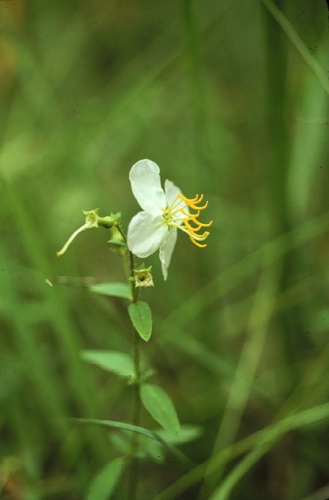Plants and Animals
Rhexia mariana Maryland meadow beauty
Key Characteristics
Small forb of coastal plain marshes; stem weakly 4-sided, bearing simple, lanceolate, opposite leaves; flowers pale pink to white with four petals and brightly contrasting yellow stamens.
Status and Rank
US Status: No Status/Not Listed
State Status: T - Threatened (legally protected)
Global Rank: G5T5
State Rank: S1S2 - Rank is uncertain, ranging from critically imperiled to imperiled
Occurrences
| County | Number of Occurrences | Year Last Observed |
|---|---|---|
| Allegan | 2 | 2022 |
| Ottawa | 1 | 1995 |
| Van Buren | 1 | 2021 |
Information is summarized from MNFI's database of rare species and community occurrences. Data may not reflect true distribution since much of the state has not been thoroughly surveyed.
Habitat
Maryland meadow-beauty is found in areas with a fluctuating water table such as coastal plain marshes, sandy lake edges, dune swales, seepages, sandy marshes, sandy and peaty edges of wetlands, and intermittent wetlands.
Natural Community Types
For each species, lists of natural communities were derived from review of the nearly 6,500 element occurrences in the MNFI database, in addition to herbarium label data for some taxa. In most cases, at least one specimen record exists for each listed natural community. For certain taxa, especially poorly collected or extirpated species of prairie and savanna habitats, natural community lists were derived from inferences from collection sites and habitat preferences in immediately adjacent states (particularly Indiana and Illinois). Natural communities are not listed for those species documented only from altered or ruderal habitats in Michigan, especially for taxa that occur in a variety of habitats outside of the state.
Natural communities are not listed in order of frequency of occurrence, but are rather derived from the full set of natural communities, organized by Ecological Group. In many cases, the general habitat descriptions should provide greater clarity and direction to the surveyor. In future versions of the Rare Species Explorer, we hope to incorporate natural community fidelity ranks for each taxon.
Associated Plants
Colic root, Indian grass, big bluestem, little bluestem, prairie willow, bushy aster, bluejoint grass, twig-rush, cross-leaved milkwort, sedge, switch grass; often associated with other coastal plain disjunct species such as tall beak-rush, Engelmann's spike-rush, flat-topped goldenrod, Maryland meadow beauty, panicled screwstem, short-fruited rush, and tall nut-rush.
Management Recommendations
This species requires conservation of habitat and protection of the hydrology, including maintenance of cyclical drawdown regime and water table. Maintain moist, open habitat. It is also vulnerable to ORV impacts and dredging and filling activities.
Survey Methods
Random meander search covers areas that appear likely to have rare taxa, based on habitat and the judgment of the investigator.
-
Meander search
-
Survey Period: From first week of August to third week of October
-
References
Survey References
- Elzinga, C.L., D.W. Salzer, and J.W. Willoughby. 1998. Measuring and Monitoring Plant Populations. The Nature Conservancy and Bureau of Land Management, Denver. BLM Technical Reference 1730-1. 477pp.
- Goff, G.F., G.A. Dawson, and J.J. Rochow. 1982. Site examination for Threatened and Endangered plant species. Environmental Management 6(4): 307-316
- Gray, A. 1950. Gray's Manual of Botany; eighth ed. Van Nostrand Reinghold, New York. 1632pp.
- Nelson, J.R. 1984. Rare Plant Field Survey Guidelines. In: J.P. Smith and R. York. Inventory of rare and endangered vascular plants of California. 3rd Ed. California Native Plant Society, Berkeley. 174pp.
- Nelson, J.R. 1986. Rare Plant Surveys: Techniques For Impact Assessment. Natural Areas Journal 5(3):18-30.
- Nelson, J.R. 1987. Rare Plant Surveys: Techniques for Impact Assessment. In: Conservation and management of rare and endangered plants. Ed. T.S. Elias. California Native Plant Society, Sacramento. 8pp.
Technical References
- Gleason, H. A., and A. Cronquist. 1991. Manual of Vascular Plants of Northeastern United States and Adjacent Canada. Second edition. The New York Botanical Garden, Bronx. 910pp.
- Godfrey, R.K. and Wooten. 1981. Aquatic and Wetland Plants of Southeastern United States. Dicotyledons. University of Georgia Press, Athens. 712pp.
- Holmgren, N.H. 1998. Illustrated Companion to Gleason and Cronquist's Manual. Illustrations of the vascular plants of Northeastern United States and adjacent Canada. New York Botanical Garden, Bronx. 937pp.
- Radford, A. E., H. E. Ahles, and C. R. Bell. 1968. Manual of the vascular flora of the Carolinas. University of North Carolina Press, Chapel Hill. 1183pp.
- Voss, E. G. 1985. Michigan Flora. Part II. Dicots (Saururaceae-Cornaceae). Bulletin of the Cranbrook Institute of Science and University of Michigan Herbarium. 724pp.


